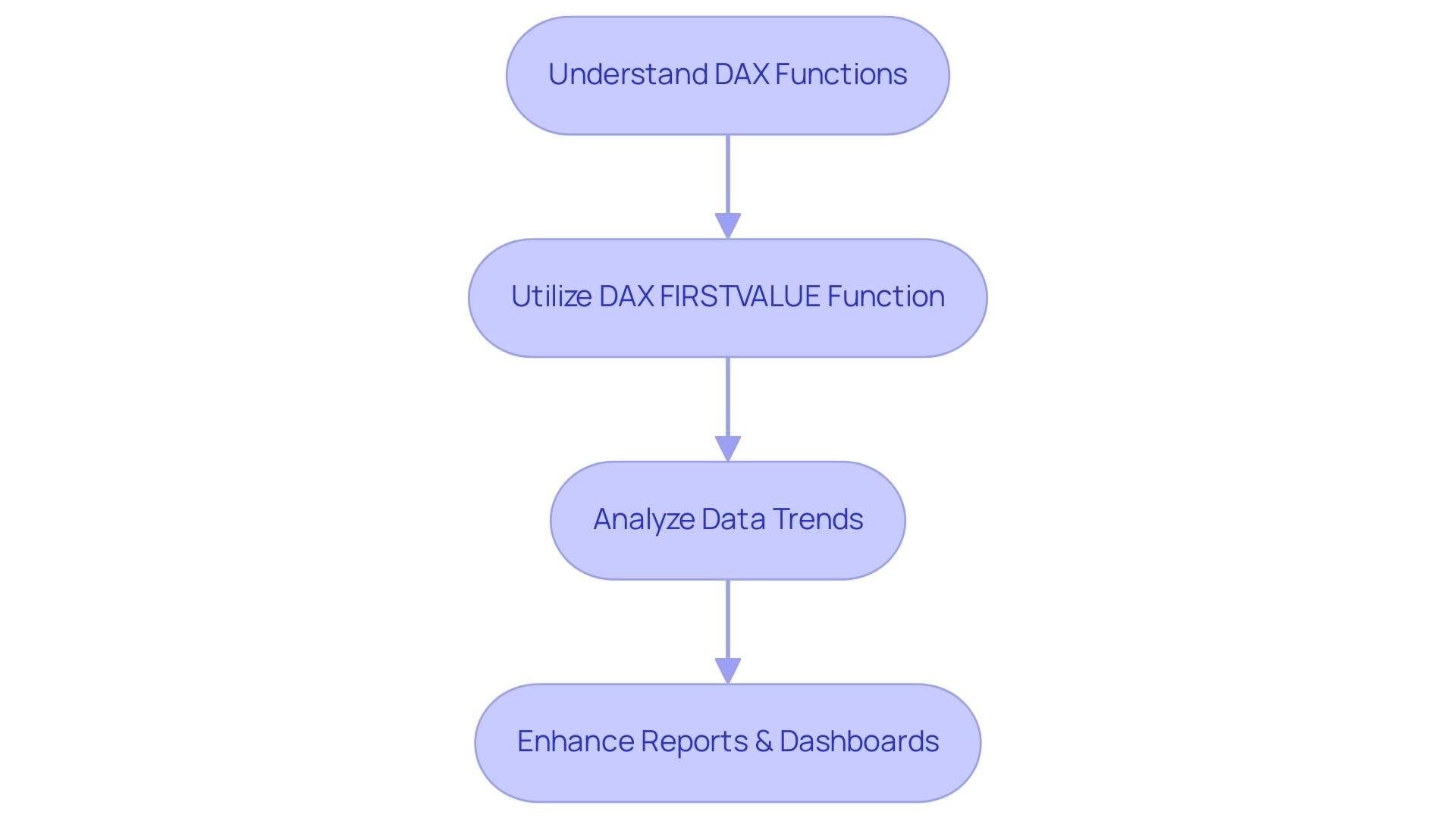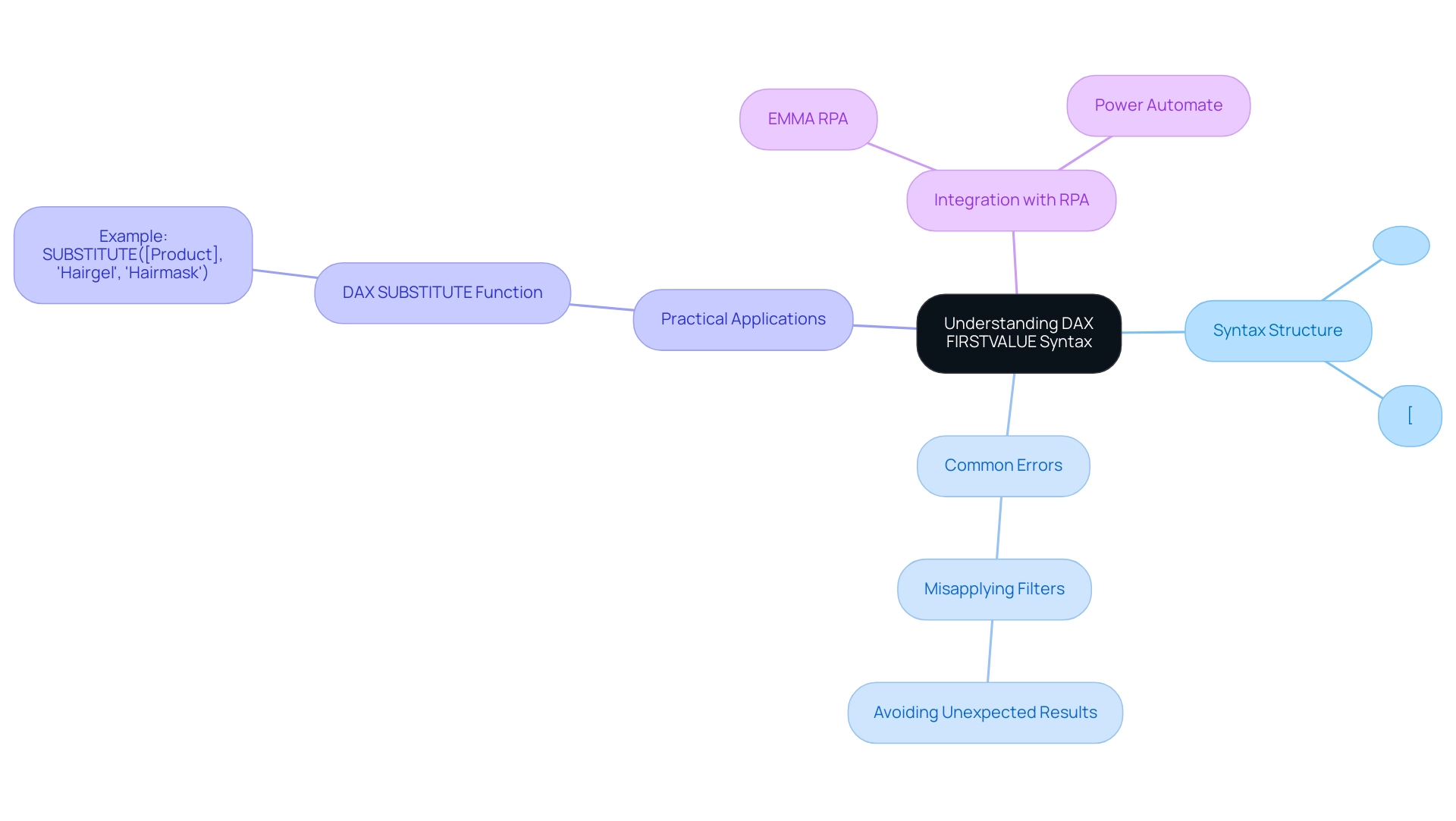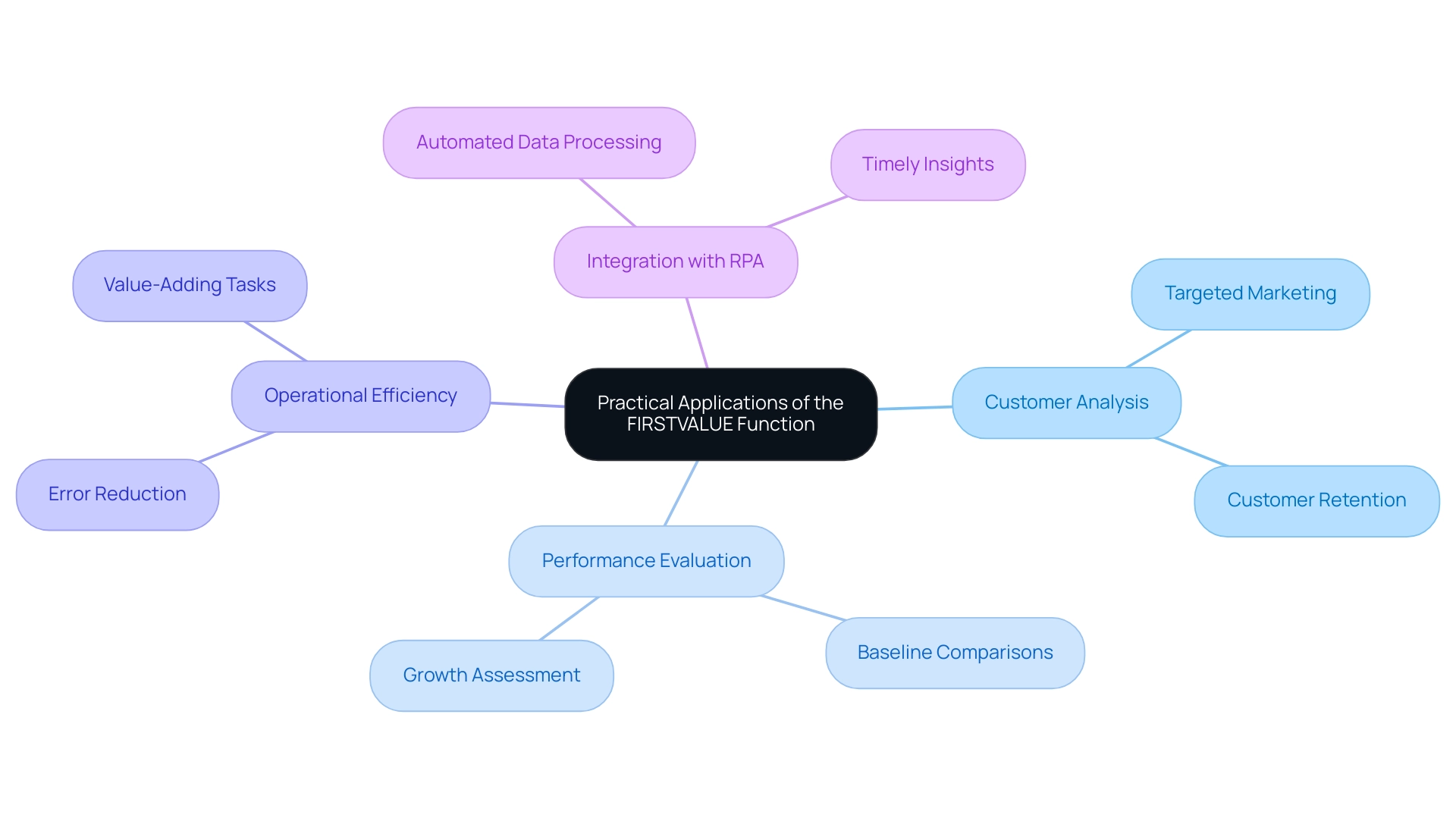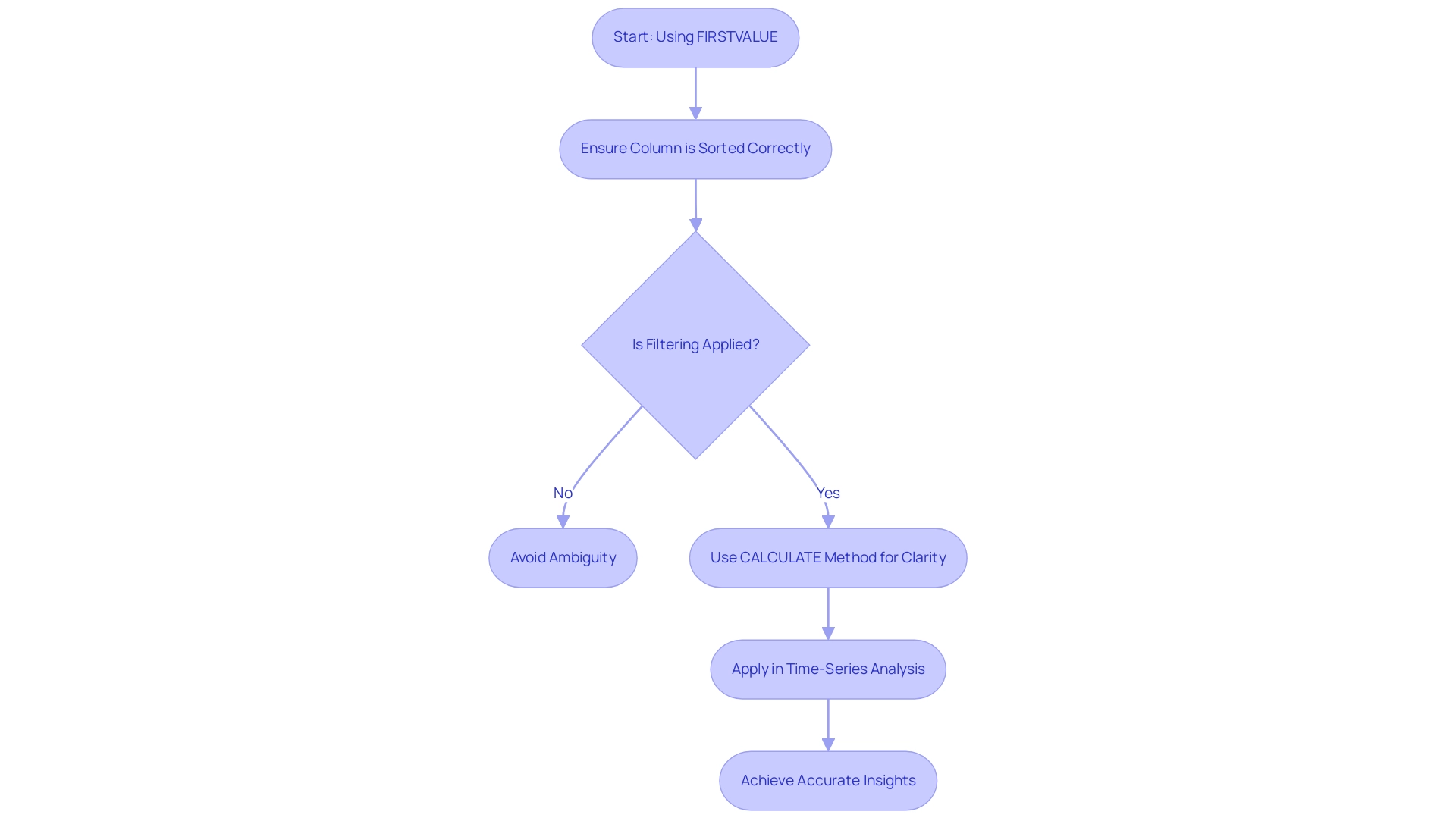Introduction
In the dynamic world of data analysis, the DAX FIRSTVALUE function emerges as a pivotal tool for professionals seeking to extract meaningful insights from complex datasets. By enabling users to pinpoint the first occurrence of a value within a specified context, FIRSTVALUE empowers analysts to uncover trends and make informed decisions that drive operational efficiency.
As organizations navigate the challenges of data management, mastering this function becomes essential for enhancing reporting capabilities and fostering a culture of data-driven decision-making. With the integration of advanced technologies like Robotic Process Automation (RPA), the potential for streamlining workflows and improving accuracy is greater than ever.
This article delves into the intricacies of the FIRSTVALUE function, exploring its syntax, practical applications, and best practices to ensure users can harness its full potential in their analytical endeavors.
Introduction to the DAX FIRSTVALUE Function
The DAX initial value capability stands out as a crucial tool in analysis, enabling users to obtain the first value in a column based on a specified filter context. This capability is invaluable for analysts aiming to track trends over time or extract initial values from complex datasets, ultimately driving data-driven insights that enhance operational efficiency. By effectively utilizing this tool, analysts can enhance their reports and dashboards, thus fostering a foundation for more informed decision-making processes.
As Suhaib Arshad, a Sales Executive turned Data Scientist, emphasizes,
With over 3 years of experience addressing challenges in Ecommerce, Finance, and Recruitment Domains, the capacity to utilize such DAX capabilities can greatly enhance one’s modeling skills in Power BI or Excel. Moreover, the incorporation of Analysis Services improves Power BI’s capabilities, offering advanced modeling features, compression, and query optimization, which additionally supports the effective utilization of DAX tools. Grasping and employing the initial value not only improves analytical skills but also provides users with crucial tools required to maneuver through the swiftly changing environment of analysis.
Significantly, valid dates in DAX are all dates following March 1, 1900, highlighting the necessity of utilizing precise date operations in information models. As we transition into 2024, mastering DAX expressions such as dax first value is essential, as they signify the foundation of efficient modeling and insightful analysis. Furthermore, utilizing Robotic Process Automation (RPA), like EMMA RPA and Power Automate, can enhance manual workflows and address issues such as time-consuming report generation and inconsistencies, ultimately promoting operational efficiency and enabling teams to concentrate on strategic initiatives.
The case study on comprehending information models and Analysis Services demonstrates how these connections facilitate cross-table analysis and deeper insights, emphasizing the practical applications and results of using DAX operations in real-world situations. Furthermore, tackling the difficulty of deriving valuable insights from data is essential, and mastering DAX capabilities is a crucial step in overcoming this challenge.

Understanding the Syntax of FIRSTVALUE
The syntax for retrieving the DAX first value of an item is organized as follows: FIRSTVALUE(<column>, [<filter>]). In this context, <column> signifies the particular column from which the first value is to be retrieved, while the optional [<filter>] enables you to specify any necessary conditions that must be met for the operation to return a result. For instance, to obtain the earliest order date from a sales table, you can use the formula: MIN(Sales[OrderDate]).
Mastering this syntax is essential for effectively utilizing the DAX first value method in your analysis, particularly in a data-rich environment where actionable insights drive growth and innovation.
Common errors often arise from misapplying the filter, leading to unexpected results. By understanding these nuances, you can avoid pitfalls and enhance your data modeling skills, ultimately improving operational efficiency through effective use of BI tools.
Additionally, it’s crucial to note that the START AT syntax follows the ORDER BY clause in the EVALUATE statement, which plays a vital role in defining the order of query results. For users working with DAX formulas, being aware of SSDT compatibility, which ranges from v14.0.1.432 to v16.0.70.21, adds credibility to your implementations.
To illustrate practical applications, consider the SUBSTITUTE tool, which replaces specified text in a string with new text. For instance, SUBSTITUTE([Product], 'Hairgel', 'Hairmask') substitutes ‘Hairgel’ with ‘Hairmask’ in the Product string, illustrating how DAX operations can be utilized effectively in real-world scenarios. As highlighted by expert Choy Chan Mun, ‘Excited to enhance your Power BI skills with this comprehensive guide!
‘💡’ This feature serves as a powerful tool in your DAX arsenal, enabling clearer insights and more precise interpretations while addressing the challenges of report creation and inconsistencies.
Moreover, to enhance operational efficiency, consider integrating RPA solutions like EMMA RPA and Power Automate to automate repetitive tasks, thereby freeing up resources for more strategic initiatives. Explore how these tools can transform your processes and drive growth in your organization. Book a free consultation today!

Practical Applications of the FIRSTVALUE Function
The DAX function serves as a powerful tool in various analytical contexts, enabling users to extract critical insights from their data. For instance, in customer analysis reports, the system can identify the dax first value of each customer’s purchase date, which is instrumental in refining targeted marketing strategies. By understanding the dax first value of when a customer first engaged with the brand, organizations can tailor their outreach efforts to enhance customer retention and loyalty.
Furthermore, this method can be applied to evaluate performance metrics over time, establishing a baseline for future comparisons and enabling clear assessments of growth or decline. This capability is further enhanced when integrated with Robotic Process Automation (RPA), which can automate the collection and processing of information, ensuring that the insights derived are timely and relevant. RPA not only reduces errors but also frees up team members to focus on more strategic, value-adding tasks, thereby enhancing overall operational efficiency.
Alongside the dax first value, the CONCATENATEX method can be employed to merge values from different columns or tables, producing detailed reports that incorporate textual insights with numerical information. This blend of capabilities simplifies information analysis and enables decision-makers to utilize past insights for strategic planning. By automating the workflow with RPA, Directors of Operations Efficiency can significantly reduce the time spent on repetitive processing tasks, allowing them to focus on interpreting insights that drive business growth.
As emphasized by Prasanth Pandey, “In Power BI, implicit measures are automatically created for basic aggregations when fields are included in visuals,” signifying the significance of effectively utilizing DAX expressions to improve analytical capabilities. Furthermore, for extensive datasets, the refined median metric can execute in under half a second, demonstrating the effectiveness of DAX operations in managing significant information. This efficiency is crucial for Directors of Operations Efficiency who rely on timely insights for informed decision-making, further bolstered by the integration of RPA into their analytical processes.
The rapidly evolving AI landscape necessitates the adoption of technologies like RPA to overcome the challenges posed by manual, repetitive tasks, ensuring organizations remain competitive and agile.

Best Practices and Common Pitfalls in Using FIRSTVALUE
Utilizing the initial value function effectively requires careful consideration of the column’s order, as ensuring the specified column is sorted correctly is crucial to obtaining reliable results. Failing to do so can lead to insights that diverge from expectations, a common challenge in leveraging Power BI dashboards due to time-consuming report creation and data inconsistencies. Moreover, it’s essential to avoid using this function in scenarios where multiple values may be returned without an explicit filter, which can introduce ambiguity into your analysis.
A best practice is to consistently pair the appropriate filtering with the DAX first value to enhance accuracy in your results. For instance, using it together with the CALCULATE method provides a clearer context: CALCULATE(InitialValue(Sales[OrderDate]), Sales[Region] = 'North'). This formula guarantees that you extract the first order date specifically for the North region, thus providing clarity and precision in your data analysis.
In practical scenarios, such as in Time-Series Analysis, the DAX first value capability can be crucial in recognizing trends and patterns over time. As Henry Chukwunwike Morgan-Dibie states, ‘Simplifying complex topics to empower understanding and decision-making,’ this principle applies to the use of DAX operations. By integrating Business Intelligence best practices and automating manual workflows with RPA solutions like EMMA RPA and Power Automate, organizations can streamline operations and make informed decisions that drive growth and innovation.
Moreover, calculated columns in Power BI enable users to generate new information through user-defined expressions, further demonstrating how this concept integrates within the wider context of DAX capabilities and their uses. The visual representation of automation, depicted in the stylized illustration of a human figure with robotic counterparts, underscores the transformative role of technology in enhancing operational efficiency.

Examples and Case Studies of FIRSTVALUE in Action
In the realm of retail analysis, the dax first value tool can profoundly influence the understanding of customer purchasing behavior. For example, examine a case study named ‘Impact of Restocking Fees and EU Legislation,’ which explores how a leading retail firm employed the function to assess their sales information. By pinpointing the first purchase date for each customer, the retailer was able to effectively segment their clientele based on distinct buying patterns.
This segmentation not only improved targeted marketing efforts but also optimized inventory management strategies by aligning stock levels with customer preferences.
Moreover, the integration of Robotic Process Automation (RPA) within this analytical framework can further streamline operations by automating tasks such as entry, report generation, and collection processes. This automation frees up valuable resources for more strategic initiatives, enhancing operational efficiency in a rapidly evolving AI landscape. RPA solutions are designed to adapt to new technologies, allowing businesses to remain agile and responsive to changes in the market.
In addition, this case study highlights how customer perceptions play a critical role in implementing restocking fees, especially in light of new EU legislation regarding free returns.
As Rita Maria DiFrancesco from Politecnico di Milano states, ‘Retailers charging a restocking fee should put more effort into increasing consumer perceived value, as customers will accept a restocking fee if they view the online purchase as having higher quality than a brick-and-mortar purchase.’ This insight highlights the necessity for retailers to enhance perceived value to successfully implement such fees, aligning with the findings from the case study.
Similarly, in the financial sector, analysts can utilize the power of dax first value to track the initial investment dates of their clients. This capability enables financial advisors to offer tailored advice that reflects each client’s unique investment journey, ultimately fostering stronger relationships and driving client satisfaction. Furthermore, utilizing RPA to automate regular analytical tasks, such as transaction processing and data reconciliation, can improve the precision and quickness of insights obtained from such data.
Practical applications of this concept illustrate how data can be converted into actionable strategies, leading to enhanced operational efficiency and profitability. Furthermore, using the stats command in a multivalue BY field can deduplicate values and return the average of another field, further enhancing the analytical capabilities when working with the dax first value function.

Conclusion
The DAX FIRSTVALUE function is a transformative tool that allows analysts to extract crucial insights from complex datasets, making it indispensable for any data-driven organization. By mastering the syntax and practical applications of FIRSTVALUE, users can not only track initial values but also uncover trends that inform strategic decision-making. This capability is further enhanced by the integration of Robotic Process Automation (RPA), which streamlines workflows and promotes operational efficiency.
Best practices for using FIRSTVALUE emphasize the importance of accurate filtering and sorting, ensuring that the insights derived are both reliable and actionable. By combining FIRSTVALUE with other DAX functions, such as CALCULATE, analysts can refine their results and gain deeper insights into their data. Real-world case studies illustrate the function’s effectiveness in diverse sectors, from retail to finance, demonstrating how it can drive targeted marketing and optimize resource management.
As organizations continue to navigate the complexities of data analysis, the ability to leverage tools like FIRSTVALUE will be central to achieving operational excellence. Embracing these advanced analytical techniques, alongside automation solutions, empowers teams to focus on strategic initiatives that foster growth and innovation. Mastering DAX functions is not just a technical skill but a vital step towards cultivating a culture of informed decision-making in an increasingly competitive landscape.

